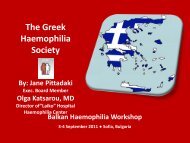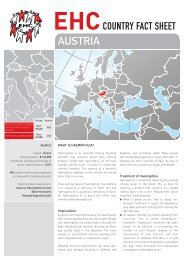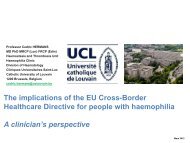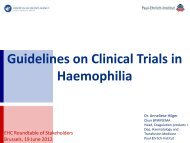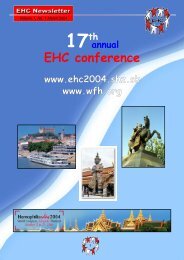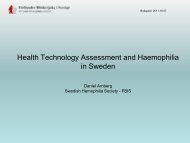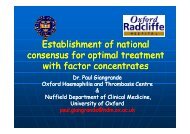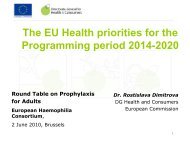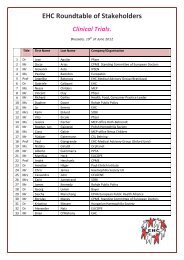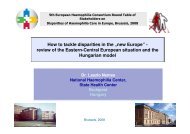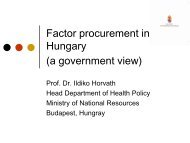Volume 2, July 2006 - EHC
Volume 2, July 2006 - EHC
Volume 2, July 2006 - EHC
- No tags were found...
Create successful ePaper yourself
Turn your PDF publications into a flip-book with our unique Google optimized e-Paper software.
<strong>Volume</strong> 2, <strong>July</strong> <strong>2006</strong>Standpoints concerning the administrationof lower doses of FVIII !Prof. Dr. Carol K. Kasper, MD, Orthopaedic Hospital, Los Angeles ‘emeritus’.Carol Kasper was during many years the Vice-President Medical of the World Federation ofHaemophilia. She is praised as a great scientistand has fully contributed to better haemophiliacare world wide but especially in Central- andSouth America. She is ‘obsessed to know moreabout haemophilia’ and besides this a great ladywith class and culture. To meet her is always ashared moment of solidarity and enrichment ofknowledgeI am, with so many others, an absolute fan ofher ’hemophilia bulletin’, and let us hope thateven as a emeritus she will continue to publish it.Her newsletter is going mainly on comments ofthe latest haemophilia innovations and presentationsduring congresses and symposia.I regularly reproduce some of her wise commentsin Forum. She has a remarkable gift forteaching. Her way to put accents on standpointsgives a much more better insight.In her newsletter November 2005 , GlobalForum she his giving her standpoint on dosageand I mean, that with her experience, her voicemust be heard.Its about ‘objective studies of dosage’ whodespite the high cost of concentrate are rare.Alok Srivastava of Vellore, India, found 13small studies, all performed more than 20 yearsago, describing lower doses than are now in commonuse. Analysis of thrombin generation assaysshows a near normal response at about 30% plasmaFVIII levels. Dr. Srivastava reviewed Dutchdata on dosage and outcome from the 1970’ to90’. As more patients got onto the home programand onto prophylaxis, and as the weekly dose forprophylaxis doubled over the decade, the numberof joint hemorrhages fell.Dr. Srivastava argues that whereas increasingthe yearly consumption of concentrate doesreduce hemorrhages and joint damage, one neednot despair if those cannot be initiated in poorercountries.An intermediate level of factor replacement,1000-2000 units/kg/year, may serve to preservefunctional independence. (That dosage level isthe current target in Brazil). For surgical operationsin Vellore, Dr. Srivastava uses a pre-operativedose that raises plasma FVIII level to 80-100%and post operative doses maintaining a throughlevel of 20-40%. His dosage scheme is similar tomine with early (1968-1970’s) elective orthopaedicsurgeries in Los Angeles. I agree that dosagehas escalated in the western world without evidencethat higher doses are necessary or advantageous.I suspect that very good results could beobtained with more modest doses. We shouldmake optimal use of less-expensive agents:physiotherapy as prophylaxis, DDAVP whereappropriate, local hemostatic agents in surgeryand tooth extraction, anti-fibrinolytic agents intooth extraction.Good management with lesser doses of concentraterequires careful attention from someonedevoted and expert. That may be the problem.Where the cost of concentrate is not an issue, it’seasy to just give higher doses and ignore thealternatives.A man in Vellore might feel discriminatedbecause he is receiving lower doses, when in reality,he is being managed much more scientificallythan a man in Los Angeles.Wouldn’t it be useful to work on a Europeanscheme because there are enormous differenceseven in the EU. From the 7,5 IU FVIII per capita inSweden to +- one IU FVIII per capita in Estonia,Bulgaria and Rumania.During the FWH Congress in Vancouver, Prof. E.Berntorp, the well known Swedish specialistabout prophylaxis, talked about a futur programlowering dosage FVIII ???Wait and see.Many thanks to Professor Dr. Carol K. Kasper –www.carolkasper.comEdmond Secq7



